These tangy and flavorful Herb Sourdough Ciabatta Rolls are perfect for sandwiches or just as a side dish dipped in olive oil. You control the flavors to match your preferred cuisine!
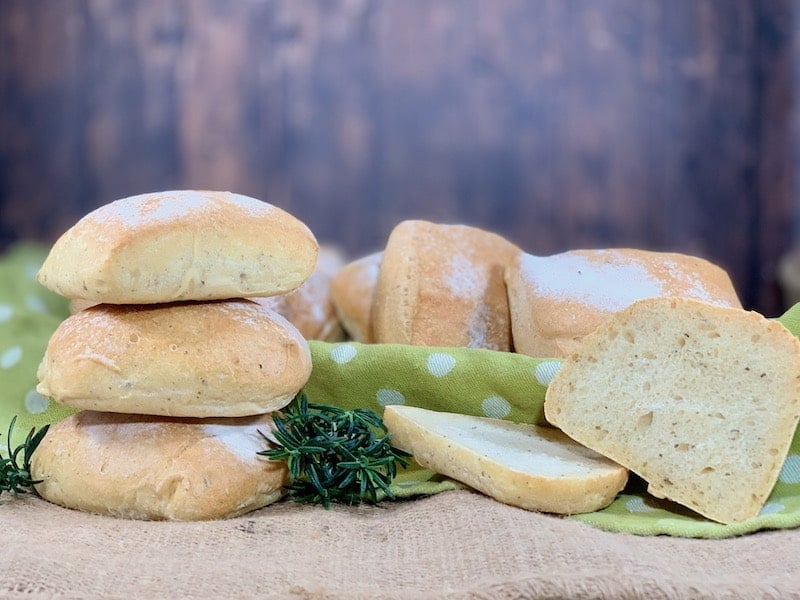
Hi, I'm Tammy! On my website, Scotch & Scones…Explorations in a glass and in the oven, I share my exploits in making desserts, baking bread, and using sourdough starter discard. Oh, and my tasting notes for scotch, whiskey, & bourbon are there, too!
Home Baked Ciabatta Rolls
There’s nothing quite like baking bread at home, especially when you're making homemade ciabatta bread. Combining simple ingredients for dough and watching it puff up, almost by magic. There’s that yeasty smell wafting through the house.
In today’s modern world of supermarkets and processed foods, baking bread almost is a way of staying grounded, returning us to what baking is about. Luckily, home baked bread is relatively easy to do and generally doesn’t require a lot of complex ingredients. Flour, water, yeast, salt…that’s all you need for a basic loaf.
Herb Ciabatta Rolls take that simple formula and add a couple of ingredients to the mix. Olive oil, milk, and herbs lend flavor and soften the dough a bit. So far, so good. How about adding some sourdough starter discard?
What is Sourdough Starter?
Long before there was commercial yeast, bakers utilized the ever-present wild yeast in their environment by nurturing it in a combination of flour and water. The yeast spores feasted on the carbs in the flour and released carbon dioxide and lactic acid (the “sour” flavoring) in return.
Bakers used a bit of that flour/water mixture in a fresh batch of dough (called “starting” your dough), and the yeast would do all the work.
Incidentally, that’s also how people started to ferment different liquids to make beer and wine, by adding a little bit of their last batch to their watery fruit or grain mixture. Then they would distill that liquid into whisky or brandy or other spirits. Yes, bread and wine are cousins, but that’s a different story.
Ahem…where was I? Oh yes, yeast.
Those bakers didn’t know it was the yeast that was making their bread rise. They did know that if the mixture wasn’t replenished with more water and flour, it would stop bubbling, resulting in a product more like a doorstop than bread.
But if you keep feeding starter without removing, you’ll end up with an overflowing crock and the starter that ate Cincinnati. So either bake more sourdough or discard some of the starter.
Baking with Sourdough Starter Discard
I refuse to throw away unfed sourdough starter, so I’ve adapted recipes to include it. Bagels, pretzels, English Muffins, focaccia, even pumpkin cake and gingerbread are just some of the ways I use my sourdough starter discard.
Even if you don’t gain active yeast from the discard, you do gain some of that lovely sourdough tang. That’s a win in my book!
How to Bake Herb Sourdough Ciabatta Rolls
Let's talk about the ingredients you'll need.
- Flour: Using a high gluten all-purpose flour (like from King Arthur Flour) is fine. If you want a chewier interior, use bread flour.
- Sourdough Starter: Fed or unfed, it’s up to you. Using fed sourdough starter might give you a better rise (depending on how vigorous your starter is), but using unfed sourdough starter discard works just fine.
- Water: You need to hydrate your dough somehow, right?
- Milk: Also used to hydrate the dough, and acts to soften the texture a bit. For a chewier loaf, replace the milk with more water.
- Olive Oil: Adds flavor. Extra virgin olive oil is best, but not necessary.
- Salt: Even with the tang from the sourdough starter discard, you’ll need salt to keep the bread from tasting flat.
- Mixed Herbs: Here’s where you really get to be creative. Use any combination of herbs you prefer. Italian herbs could include rosemary, oregano, basil, but you can use other combinations like sage and thyme or herbs de Provence. You can use either fresh, dried, or a mixture of the two.
- Yeast: Provides the rise, especially if you’re using unfed sourdough starter.
WANT TO SAVE THIS RECIPE?
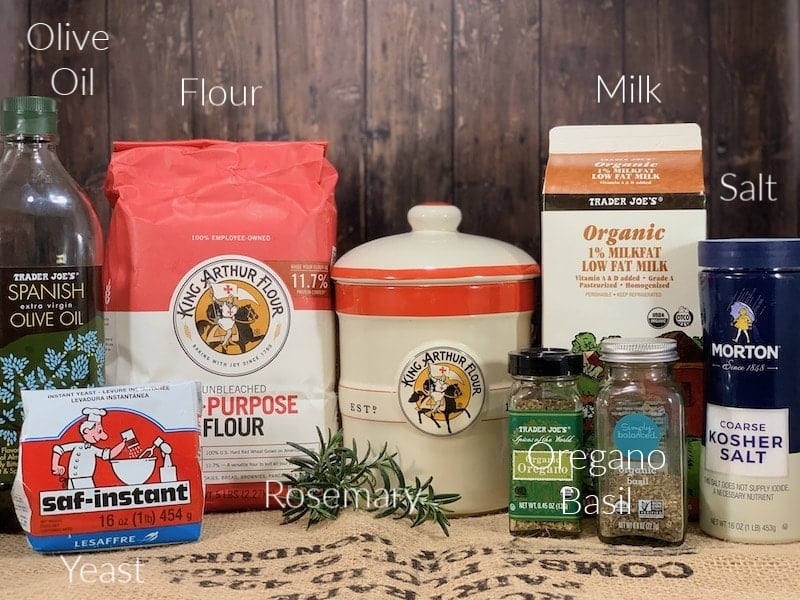
Equipment You'll Need
- Stand mixer fitted with a dough hook: Not technically necessary, but quite useful. You can also use the manual cycle on a bread machine, or get a good arm workout by kneading the dough by hand.
- Bench scraper: Helps with portioning out the dough without tearing into a mat (if you're using one). You can also use a chef's knife.
- Half sheet baking pans (2): These rolls need space, so two baking pans are helpful.
- Silpat silicone mat or parchment paper: I love my Silpat mats, but parchment paper is fine. You can also bake on baking stones if you have them.
- Large frying pan: Used to create steam in the oven.
- Spray bottle: To spray the rolls with water before they go into the oven.
Expert Tips
- In order to get that nicely browned exterior, add a large skillet filled with about two cups of water to the oven before you start to preheat it. The warming oven will heat the water. Just be careful when you open the oven to put in the dough or you’ll get a faceful of steam (and this isn’t spa day).
- Speaking of preheating the oven, let it heat for and additional 30 minutes or more after it tells you it’s ready to make sure the entire oven is uniformly hot. This will help the loaves spring up no matter which rack the baking pans are on.
- A word about flour amounts...to achieve a ciabatta’s open, airy crumb, the dough needs to be slacker than a normal white bread, but the rolls also need to be able to hold their shape in the oven. Too much flour will yield rolls with a texture that doesn’t have those holes. Not enough flour and the rolls just flatten out. Start with the lesser amount of flour and add more in two tablespoon increments.
- Using fed sourdough starter might give you a better rise (depending on how vigorous your starter is), but using unfed sourdough starter discard works just fine.
- Use any combination of herbs you prefer. Italian herbs could include rosemary, oregano, basil, but you can use other combinations like sage and thyme or herbs de Provence. You can use either fresh, dried, or a mixture of the two.
- I always rotate my baking sheets (front to back and switching racks) halfway through the cooking time. If you decide to do that, work quickly so you don’t lose too much steam in the process.
This is a trial-and-error process, people, so just…uhm…roll with it.
This is what the dough will look like before and after proofing the dough (the first rise).
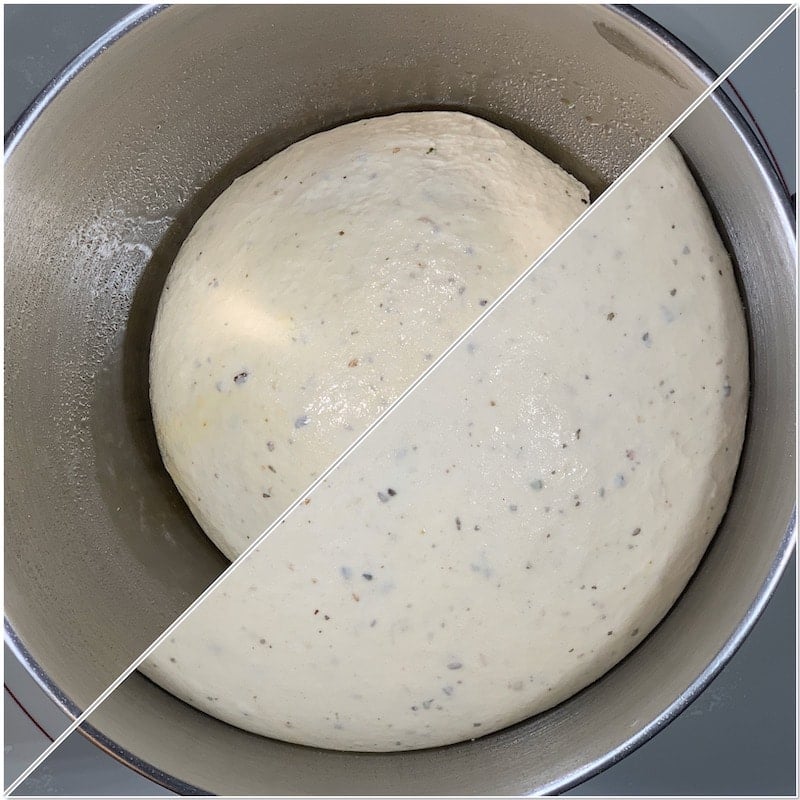
After the first rise, portion out the dough.
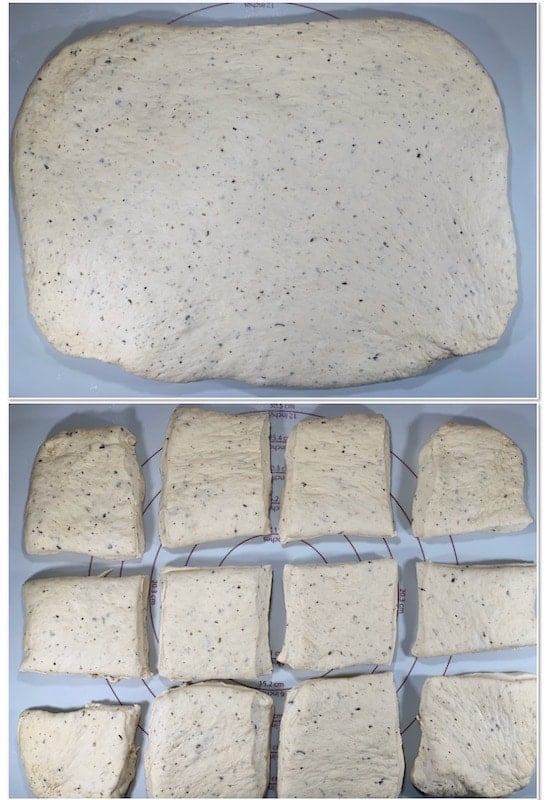
Make sure you have enough space for the rolls to rise. Check out that lovely golden crust!
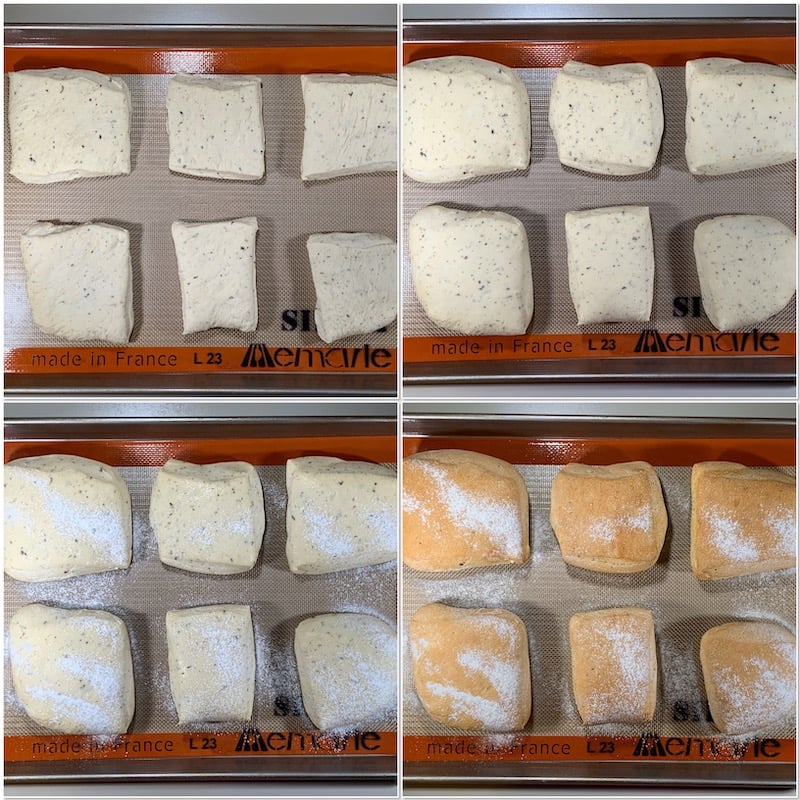
Using Sourdough Ciabatta Rolls
These ciabatta rolls are better than the supermarket's offerings, with assertive herb flavor coupled with that wonderful sourdough tanginess. So what can ciabatta rolls be used for? So many things!
- Use them as sandwich rolls or to make a delicious garlic bread to serve alongside Penne Pasta with Italian Marinara Sauce or Italian Marinara with Meatballs.
- I used rosemary, oregano, and basil for a wonderful base to my salami and provolone sandwich. Use whatever herbs you’d like to compliment the cuisine you’ll be serving.
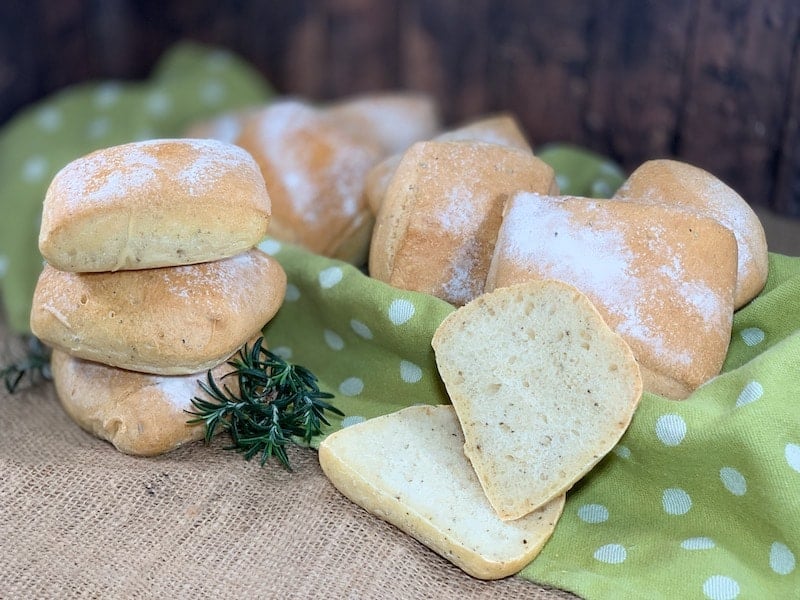
Get back to basics with baking bread at home, then take your bread baking up a notch with ciabatta bread made with sourdough starter discard.
No waste, just mouth-watering ciabatta bread goodness. Yummm…
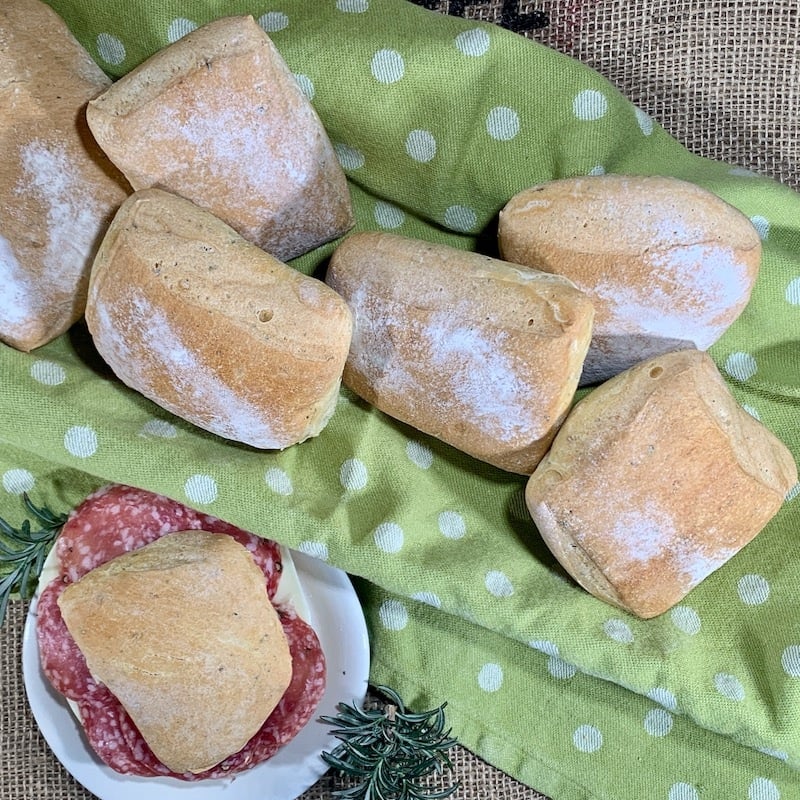
Stay Updated! Get all the latest tasty goodness straight to your inbox by signing up to receive my weekly email for the latest and greatest recipes!
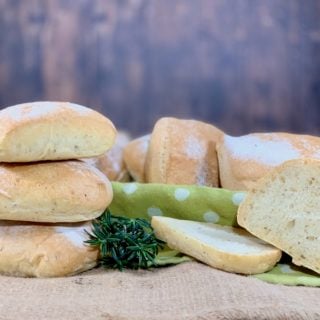
Herb Sourdough Ciabatta Rolls
Equipment
- stand mixer fitted with a dough hook
- bench scraper
- half sheet baking pans (2)
- Silpat silicone mat or parchment paper
- large frying pan
- spray bottle
Ingredients
- 6 to 7 cups all purpose flour (25-½ oz to 30 oz, 723g to 844g)
- 1 cup sourdough starter (8-½ oz, 225g) fed or unfed, room temperature (see Recipe Notes)
- 1-¼ cups water (10 oz, 283g) lukewarm
- ¾ cup milk (6 oz, 170g) lukewarm
- 1 tablespoon olive oil (½ oz, 14g)
- 1 tablespoon salt
- 1 tablespoon mixed herbs chopped (see Recipe Notes)
- 2 teaspoon yeast
Instructions
- In the bowl of a stand mixer, mix all the dough ingredients together, using 6 cups (25-½ oz, 723g) of the flour. Knead the dough with the dough hook (or turn onto a lightly floured work surface to knead by hand) until you have a smooth, yet slack dough. Add more flour only as necessary in two tablespoon increments to make a smooth, satiny, elastic dough. The dough should definitely be on the slack side, but not oozy (see Recipe Notes).
- Place the dough in an oiled bowl and cover. Let it rise in a warm spot for about 1-2 hours, or until it doubles in size. You can use a controlled-temperature bread proofer or just the oven with the light turned on.
- Gently deflate the dough and turn it onto a lightly floured work surface.
- Pat the dough into a rectangle about 9- x 16-inches. Cut into twelve 3- x 4-inch rolls using a bench scraper or chef’s knife. Try to make the rolls approximately the same size, but don’t stress about exact measurements.
- Place the rolls on two half sheet baking pans lined with Silpat silicone mats or parchment paper, six to a sheet. Space the rolls a little…they'll need room for expansion. Cover the rolls with a towel and let them rise until puffy, about 30 minutes.
- While the rolls rise, preheat the oven to 425°F. Place a large frying pan filled with water in the bottom of the oven (off to one side). The water will warm while the oven is heating, creating a steamy environment so the crusts gets nice and brown.
- Spray the loaves with water and sift a thin layer of flour on top. Bake the rolls for 15 minutes, then rotate the baking sheets, working quickly (see Recipe Notes). Lower the oven temperature to 375°F, and bake for an additional 15 to 20 minutes, until the rolls are a deep golden brown.
- Remove the rolls from the oven, turn off the oven, and return the rolls to the oven with its door cracked open a couple of inches. Let rolls cool completely in the cooling oven.
Notes
- Using fed sourdough starter might give you a better rise (depending on how vigorous your starter is), but using unfed sourdough starter discard works just fine.
- Use any combination of herbs you prefer. Italian herbs could include rosemary, oregano, basil, but you can use other combinations like sage and thyme or herbs de Provence. You can use either fresh, dried, or a mixture of the two.
- To achieve a ciabatta’s open, airy crumb, the dough needs to be slack, but the rolls also need to be able to hold their shape in the oven. Too much flour will yield rolls with a texture that doesn’t have those holes. Not enough flour and the rolls just flatten out. This is a trial-and-error process, people, so just…uhm…roll with it.
- I always rotate my baking sheets (front to back and switching racks) halfway through the cooking time. If you decide to do that, work quickly so you don’t lose too much steam in the process.
- In order to get that nicely browned exterior, add a large skillet filled with about two cups of water to the oven before you start to preheat it. The warming oven will heat the water. Just be careful when you open the oven to put in the dough or you’ll get a faceful of steam (and this isn’t spa day).
- Speaking of preheating the oven, let it heat for and additional 30 minutes or more after it tells you it’s ready to make sure the entire oven is uniformly hot. This will help the loaves spring up no matter which rack the baking pans are on.
- A word about flour amounts...to achieve a ciabatta’s open, airy crumb, the dough needs to be slacker than a normal white bread, but the rolls also need to be able to hold their shape in the oven. Too much flour will yield rolls with a texture that doesn’t have those holes. Not enough flour and the rolls just flatten out. Start with the lesser amount of flour and add more in two tablespoon increments.

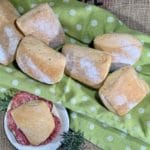
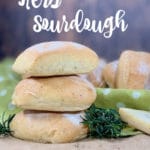

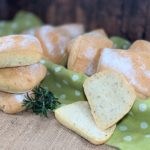

Amy Liu Dong
Such an easy, and delicious bread to make. Perfect to be paired with your favorite holiday soup.
Amanda Mason
So glad you found it easy to make!!
Jamie
Wow! This dough recipe looks incredibly delicious and yummy! Plus it's healthy that will be loved and enjoyed by everyone!
Amanda Mason
Please let me know how it turns out for you! I can't wait to hear!
Zhen
This was delicious! Used fresh and dried like you suggested and it was so good!
Amanda Mason
Yeah! So glad to hear you loved them!
Ann
I love sourdough bread! Adding the herbs sounds like a great mix up to the bread! Excited to give it a try!
Amanda Mason
Keep me in the loop on how it turns out for you! I can't wait to hear!
D griffin
Great Recipe. Tasty and crusty exterior.
Amanda Mason
Yeah! So glad you enjoyed them! I can't wait to hear what other recipes of mine you make so let me know!!
DG
I haven't made ciabatta with sourdough starter yet I normally use Bigga, but as soon as the weather allows (it's in the mid 90°'s to 107° all this week & part of next week 🔥)
but I'll try your recipe soon👍
Thank you
Amanda Mason
I can't wait to hear how you like it/how it turns out!
Deborah Schoefield-Harvey
Just tried the herb ciabatta recipe, started off as quite a stiff dough, wondered if I should put some more oil or water in it, but thought I'd leave it this time, amazing rolls, the crust was so good, I'll definitely be makes these again, thanks
Tammy Spencer
Wonderful! I'm glad you like this recipe 😉
Judy
I made these today and they turned out fantastic!! Perfect for sandwiches!!
Amanda Mason
Hi Judy! Yeah! I'm so glad you are enjoying the Ciabatta rolls! They are my absolute favorite!!! Let me know what other recipes of min you try!! I can't wait to hear!
Jeanna Schnurbusch
I'm running very low on yeast and there's none to be found in stores. Think I could get away with using just my very active starter?
Tammy Spencer
Hi Jeanna, that’s a great question. If your fed sourdough starter is reliably active, I would think that you could use it alone with a couple of caveats. First, you’ll want to give the dough anywhere between 2 - 5 hours for the first rise, and maybe the same amount for proofing as well. Commercial yeast helps to jump start the process, so be patient. You know how your starter behaves when you make your sourdough, so you should expect the same results here. The other factor would be to reduce the amount of olive oil or leave it out altogether as it can inhibit rising.
Please let me know how it goes. Good luck & happy baking!
Scarlet | Family Focus Blog
I have always avoided making bread (other than in the bread maker) but now that I am getting so much extra time at home with my kids, I think this would be a good idea for us to learn together. Thanks for the recipe!
Tammy Spencer
Baking bread with kids is a great experience, from learning math & science to kneading & shaping. Enjoy! 😉
Kay
We love baking bread but hadn't ever tried to make ciabatta bread before....... they were fabulous! Great for a tuna and cheese melt.
Tammy Spencer
Hi Kay, I'm glad you liked the ciabatta rolls! What kind of bread do you normally make?